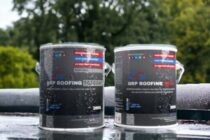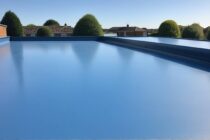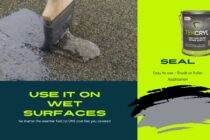Roof repair paint with fibres
Roof repair paint with fibres is a type of coating that has become increasingly popular in recent years due to its ability to provide additional strength and durability to roof surfaces. This type of paint contains fibers or strands of material, such as fiberglass or polyester, which are designed to reinforce the paint and prevent cracking, peeling, and other types of damage.

In this article, we will explore the benefits of roof repair paint with fibers, the types of fibers used, and the application process.
Benefits of Roof repair paint with fibres
Roof repair paint with fibers offers a number of benefits, making it an attractive option for homeowners and contractors alike. Some of the key benefits include:
- Increased Durability: The fibers in roof repair paint provide additional strength and durability to the surface, making it less likely to crack, peel, or otherwise become damaged over time.
- Improved Weather Resistance: Roof repair paint with fibers is designed to withstand a wide range of weather conditions, including wind, rain, and snow.
- Cost-Effective: Roof repair paint with fibers is a cost-effective alternative to more extensive roofing repairs or replacements, allowing homeowners to extend the life of their roof without breaking the bank.
Types of Fibers Used in Roof Repair Paint
There are several types of fibers that may be used in roof repair paint, including:
- Fiberglass: Fiberglass is a common choice for roof repair paint with fibers due to its strength and durability. It is also lightweight and easy to work with, making it a popular option for contractors.
- Polyester: Polyester fibers are another popular choice for roof repair paint, as they are resistant to moisture and have a high degree of flexibility, allowing them to conform to the shape of the roof surface.
- Cellulose: Cellulose fibers are made from wood pulp and are a biodegradable alternative to synthetic fibers. While less commonly used in roof repair paint, cellulose fibers can provide additional strength and durability to the surface.
Application Process for Roof Repair Paint with Fibers
When applying roof repair paint with fibers, it is important to follow the manufacturer’s instructions carefully. The application process typically involves the following steps:
- Clean the surface: Before applying the paint, the roof surface must be thoroughly cleaned and allowed to dry completely.
- Prepare the paint: The roof repair paint with fibers should be stirred thoroughly before use to ensure that the fibers are evenly distributed throughout the paint.
- Apply the paint: The paint can be applied using a brush or roller, working in one direction to ensure proper coverage. It is important to apply the paint in thin, even coats, and to follow any specific instructions provided by the manufacturer.
- Allow to dry: After applying the paint, it is important to allow it to dry completely before exposing it to any moisture or weather. Drying times may vary depending on the temperature and humidity levels in the area.
Uses: CrylicRoof
is ready for use and is cold applied to all types of roofs, including flat and pitched as well as bituminous surfaces, gutters, brickwork, asbestos (see porous substrates section), concrete, felt, metal and fiberglass surfaces. CrylicRoof is not suitable for walkways or balconies and is not suitable for us on PVC or timber surfaces or for internal use
Surface Prep
Remove all loose contamination from the roof such as chippings, moss, lichen, dust, and dirt. Where growth was present the area should be treated with a fungicidal wash in accordance with manufacturer instructions. Metal surfaces should be cleaned with a wire brush to remove rust and provide a key. Any splits or blisters should be cut and sealed prior to application.
Application
Always try a test patch prior to large-scale applications. Apply a generous coating of CrylicRoof to the area using a brush or roller at a rate of 1-2 kg per m2 depending on the substrate, the recommended application temperature is between 5°C – 25°C. CrylicRoof can be applied to damp surfaces and can bridge cracks of several mm wide due to the fiber content. Any larger voids should be filled with a suitable tape reinforcement, see the separate data sheet. CrylicRoof has a drying time of 2-3 days depending on atmospheric conditions but will be waterproof immediately after application.
Suitable substrate
METALS POROUS SUBSTRATES: Asbestos cladding, sheeting, and guttering as well as concrete should be primed before applying CrylicRoof using CrylicPrime, see separate data sheet for details.
NON-POROUS SUBSTRATES. Ensure that polished bricks and slate have been power washed prior to applying CrylicRoof, the substrate should be completely dry and free from any contamination.
BITUMEN SURFACES: Please note that discoloration may occur when CrylicRoof is applied onto new asphalt, bitumen, or tar surfaces meaning an extra coat may be required. In addition, old bitumen may crack, in this case, further advice should be sought.
PREVIOUSLY COATED OR PAINTED SURFACES: Ensure that an inspection of the substrate has been carried out, and adhesives tests on any existing coating or substrate prior to application are highly recommended.
Material Safety
CrylicRoof is flammable and must be kept away from ignition sources Ensure that air conditioning vents are sealed for a minimum of 24 hours during and after application For cleaning equipment, use white spirit. Good working practices should always be followed; walking boards should be used when needed. All information is given in good faith and is based on our knowledge and experience but without liability. As CrylicRoof have no control over application methods employed by the applicant, any warranty either written or implied is given in good faith and can only cover the material itself. If you are in doubt or have any questions, please contact your supplier for advice. An MSDS is available on request.
Conclusion
Roof repair paint with fibres is an effective and cost-efficient way to extend the life of a roof surface. By providing additional strength and durability, this type of paint can prevent cracking, peeling, and other types of damage, and withstand a wide range of weather conditions. When applying roof repair paint with fibers, it is important to follow the manufacturer’s instructions carefully and choose the type of fibers that are best suited for the specific needs of the roof surface.




